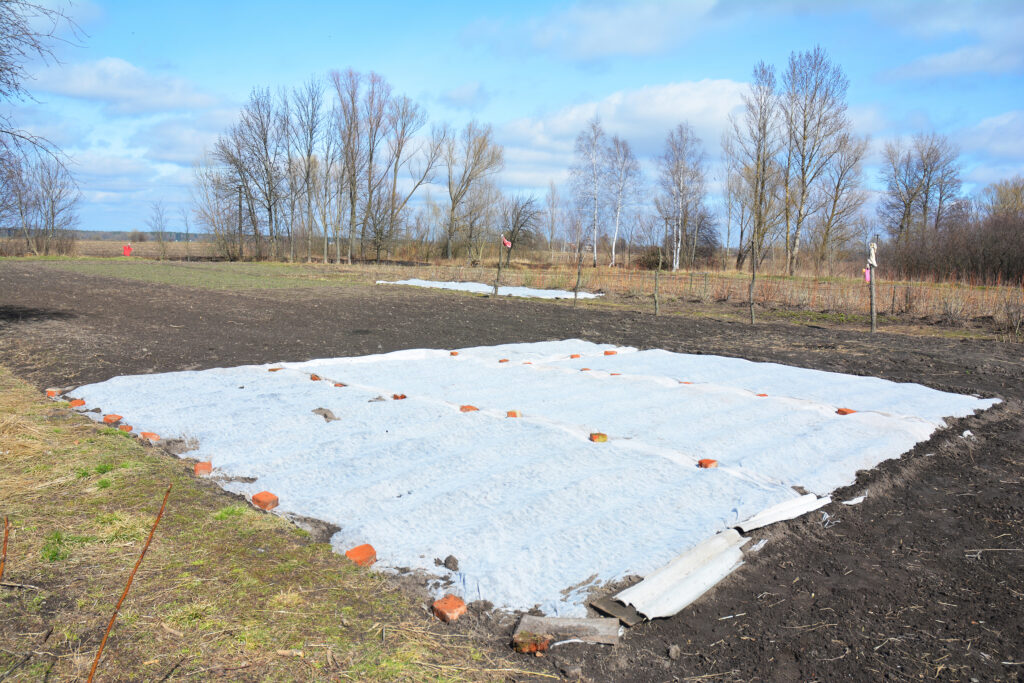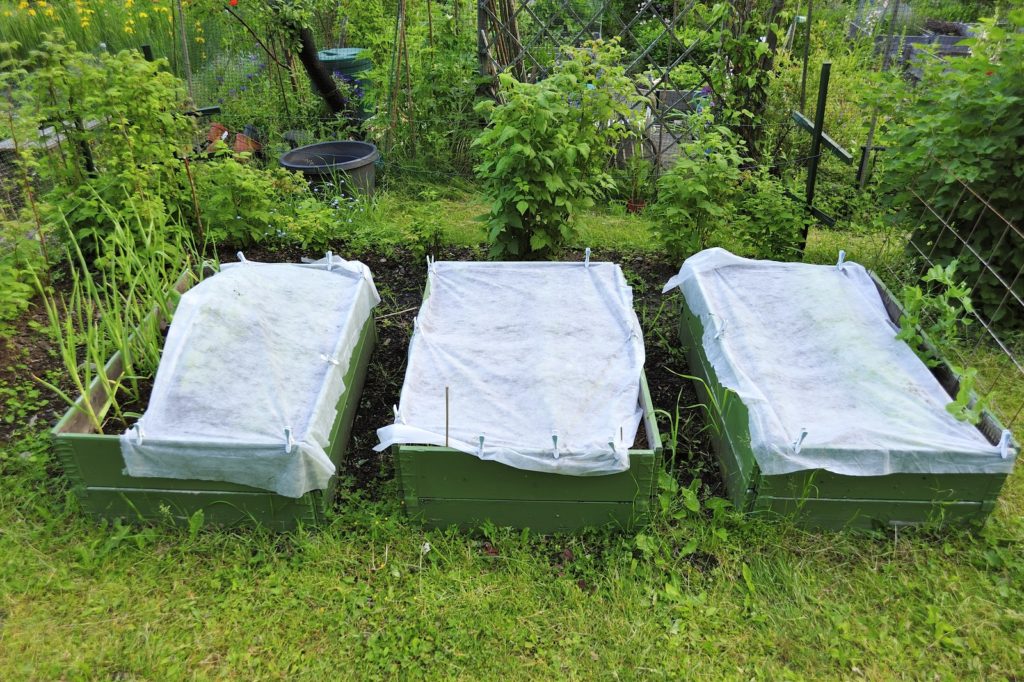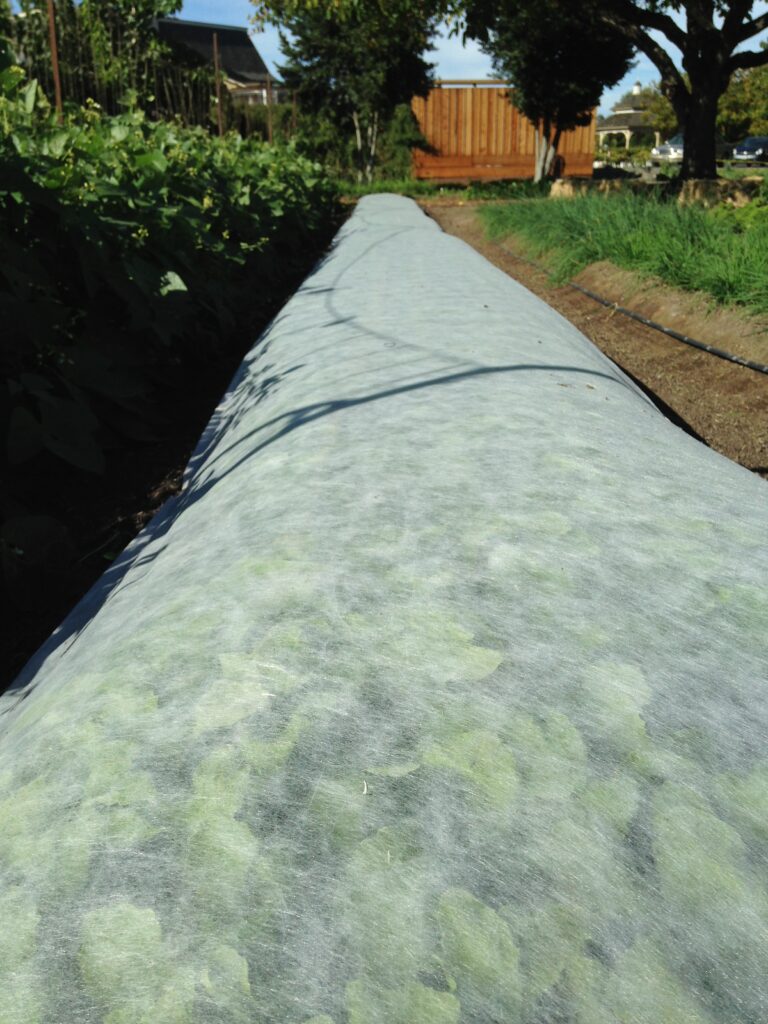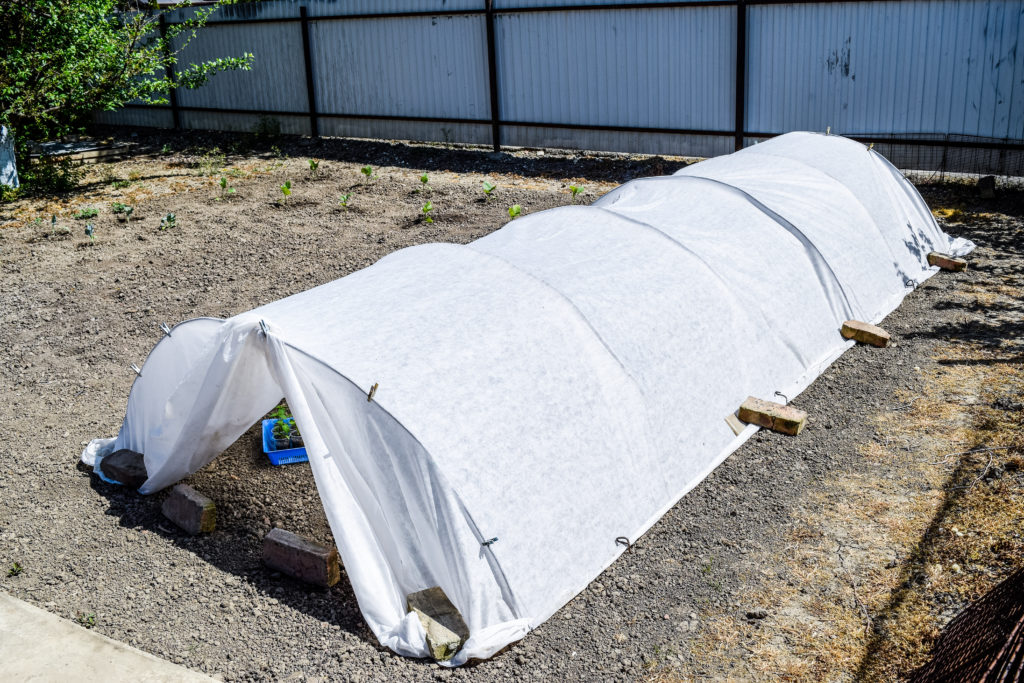A row cover is a lightweight, translucent fabric or plastic cover used to protect plants from inclement weather and pests. Row covers are also know as fabric row covers and floating row covers.
Row covers are commonly sheets or rolls of spun-bonded polyster material that can be easily rolled or draped over a row of plants. When a row cover is set directily on plants it is called a floating row cover; it can float up and down with the growth of the plant. When a row cover is placed over plastic or metal hoops it can form a tunnel.
Row covers are usually anchored on all sides with garden staples, stakes, stones, or soil. A row cover will trap warm air around plants raising the temperature by 2 to 6 degrees Fahrenheit. Row covers are among the most commonly used season extending devices in the garden; they essentially function as lightweight and portable greenhouses.

About row covers
Row covers are usually made of lightweight, translucent, spun-bonded polyester or polypropylene material in sheets or rolls between 5 to 10 feet wide and 10 to 250 feet or more long. Row covers usually allow about 75 percent of sunlight to reach plants and nearly 100 percent of water can penetrate easily. Some row covers are slitted to prevent overheating during periods of temperature fluctuation.
Clear plastic can be used as a row cover, but plastic sheeting is usually heavier than fabric and is commonly supported by metal, fiberglass, or plastic hoops or wooden stakes so that it does not lay directly on plants.

How row covers are used
Row covers are used to protect seedlings and plants from anilmals, flying pests, and seasonal temperature extremes (early spring and late fall). Fabric row covers allow light and water to enter; they also help the soil retain moisture and heat.
When draped over beds or hoops, row covers create mini-greenhouses that trap warm air and raise the temperature around developing plants. They are similar to cloches and hot caps but on a larger scale. Row covers keep birds from eating seeds and seedlings and insects from laying eggs that hatch into hungry larvae. Row covers keep wildlife from nibbling on plants.

Types of fabric row covers
Fabric row covers are available in light, medium, heavy, and extra heavy weights. The lighter fabric weights are mostly used for insect protection, while the heavier weights are used for frost protection. A medium weight row cover is a good all-purpose choice. Clear plastic can also be used a row cover.
Row cover weights
Row covers are measured or graded by the weight in ounces per square yard of fabric. Heavyweight covers weigh 2 ounces per square yard; medium weight covers weigh 1¼ ounce per square yard; lightweight covers weigh a half ounce per square yard.
Heavyweight row covers
Heavyweight covers (2 ounces per square yard), also called garden blankets or quilts, are commonly made of thick, close-knit polypropylene fibers. These covers are best supported above plants by plastic or fiberglass hoops or wooden frames.
Heavyweight covers can protect plants to 24°F and are commonly used in late winter or early spring to protect plants from frost or short freezes allowing the growing season to begin as much as 3 to 4 weeks earlier than average.
In cold-winter regions, heavyweight covers also can be used in late autumn and early winter to keep freezing weather from harming crops until harvest and delay soil freezing (protecting root crops). In the mild-winter regions, heavyweight covers can be used to protect root and leaf crops for harvest all winter or wintering over crops for early spring harvest.
Heavyweight row covers will block from 40 to 50 percent of sunlight and is best not used once temperatures have settled above freezing and plants begin active growth. The temperature under a heavyweight cover in warm weather can rise to as much as 20 degrees warmer than the outside temperature
Medium-weight row covers
Medium-weight or all-purpose row covers (1¼ ounces per square yard) are commonly made from spun-bonded polyester or polypropylene knitted fabric and are placed on supports over young crops or floated over the tops of stronger, mature plants.
Medium-weight row covers will protect plants from frost damage down to 28°F (2 to 6 degrees of protection). These covers will protect plants from strong winds, heavy rain, and even hail but allow light, air, and water to reach plants.
Medium-weight row covers allow from 70 to 85 percent of sunlight to reach plants and can be used for light shading in summer. Medium-weight covers also can be used to exclude insects and other pests early in the growing season.
Light-weight row covers
Lightweight floating row covers are used to shield plants from insects and diseases in spring and summer. Shade cloth is used to shade soil and plants in hot summer weather.
Lightweight row covers that are permeable to air and water and weigh about a half ounce per square yard usually do not require venting but they should be lifted when pollinating insects visit crops. Lightweight row covers can transmit up to 85 percent of the available sunlight.
Light-weight or summer-weight row covers (one-half ounce per square yard) are used to protect plants from insects, birds, and insect-borne diseases. Light-weight row covers transmit up to 95 percent of sunlight to plants. These covers are not used for frost protection, will not overheat plants in hot weather, and readily allow rain and irrigation to reach plants.

Row cover use tips
Judge whether a plant is sturdy enough to support a floating row cover or if a framework or stakes should be used to support the weight of the cover.
Young seedlings are typically delicate and unable to bear the weight of a row cover. Use supports to protect seedlings from the weight of a row cover. Set wire hoops over seedlings then stretch the fabric over the hoops. Hold the cover in place by clipping the hoops or weighing down the edges with stones or soil.
Once plants become sturdy you can allow the row cover to float atop the plant. Use enough fabric so that the cover can float up with plant growth yet the edges of the cover can remain anchored.
When using row covers, keep in mind that heat can build up under the covers and ventilation may be needed so that the air around plants does not become too warm.
Row covers must be removed from fruiting plants just before bloom to allow for pollination.
See also:
Cloche and Hot Cap Buyer’s Guide
Related articles:
Plastic Tunnels for Grow Vegetables
Vegetable Garden Season Extension















